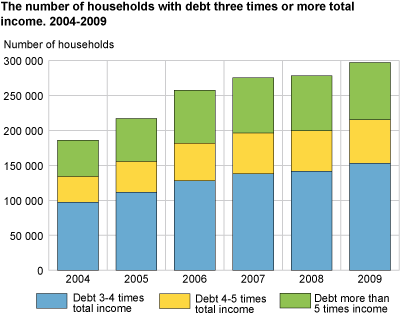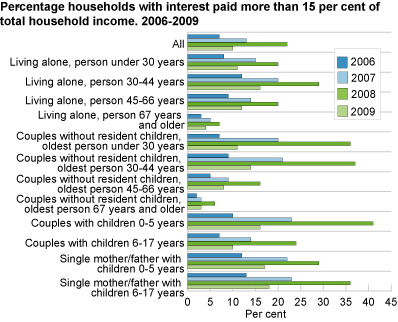Content
Published:
This is an archived release.
More debt - less interest paid
Norwegian households with debt more than three times the size of their household income increased from 2008 to 2009. At the same time, fewer households had interest paid that amounted to more than 15 per cent of total income. This is related to the development in the interest rate.
Nominal interest on loans increased from 4 per cent in 2004 to 7.3 per cent in 2008, and then decreased to 4.3 per cent in 2009.
The share of households that had interest paid amounted to more than 15 per cent of total income was halved from 2008 to 2009. This applied to 22 per cent of all households in 2008, and 10 per cent of all households in 2009.
Norwegian households have increased their debt burden over the past years. From 2004 to 2009 the proportion of households with a debt more than three times the size of their income, increased from 9 to 14 per cent. In the same period the share of households without debt was reduced from 19 per cent to 17 per cent.
Underlying dataAs of 2004, the household income statistics are based solely on register data, including all persons in private households living in Norway at the end of the year. Persons in student households are not included. In addition to registered cash income received by households, the statistics also include debt and wealth registered in the tax assessment. Thus, the valuation of wealth is based on the tax-assessment value. Consequently, the statistics show a lower value on some objects than the actual market value. This primarily applies to real properties (for instance the value of private homes). The property value is also affected by changes in the tax rules. See " About the statistics " for more information . |
Tables:
- Table 1 Property account for households. 2008 og 2009. NOK million, part of households that have amount on the different property codes and their average
- Table 2 Households by size of debt and type of household. 2009. Per cent
- Table 3 Average debt and per cent changes in average debt for households in different deciles for total household income. NOK and per cent. 2004-2009
- Table 4 Households with bank deposits higher than 1 G (Basic amount of the National Insurence )
The statistics is published with Income and wealth statistics for households.
Additional information
The statistics are based on register data, including all persons in private households. Persons in student households are not included. Registered cash income and debt and wealth registered in the tax assessment are included.
Contact
-
Statistics Norway's Information Centre
E-mail: informasjon@ssb.no
tel.: (+47) 21 09 46 42


